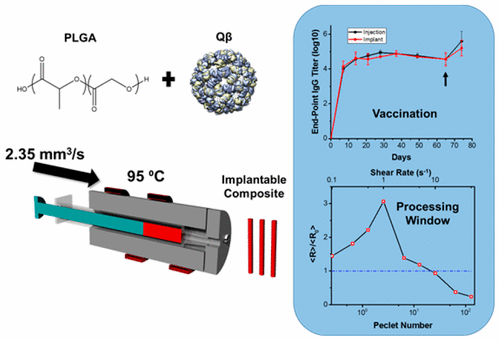Our official English website, www.x-mol.net, welcomes your feedback! (Note: you will need to create a separate account there.)
Biodegradable Viral Nanoparticle/Polymer Implants Prepared via Melt-Processing
ACS Nano ( IF 17.1 ) Pub Date : 2017-09-13 00:00:00 , DOI: 10.1021/acsnano.7b02786 Parker W. Lee 1 , Sourabh Shukla 1 , Jaqueline D. Wallat 1 , Chaitanya Danda 1 , Nicole F. Steinmetz 1 , Joao Maia 1 , Jonathan K. Pokorski 1
ACS Nano ( IF 17.1 ) Pub Date : 2017-09-13 00:00:00 , DOI: 10.1021/acsnano.7b02786 Parker W. Lee 1 , Sourabh Shukla 1 , Jaqueline D. Wallat 1 , Chaitanya Danda 1 , Nicole F. Steinmetz 1 , Joao Maia 1 , Jonathan K. Pokorski 1
Affiliation

|
Viral nanoparticles have been utilized as a platform for vaccine development and are a versatile system for the display of antigenic epitopes for a variety of disease states. However, the induction of a clinically relevant immune response often requires multiple injections over an extended period of time, limiting patient compliance. Polymeric systems to deliver proteinaceous materials have been extensively researched to provide sustained release, which would limit administration to a single dose. Melt-processing is an emerging manufacturing method that has been utilized to create polymeric materials laden with proteins as an alternative to typical solvent-based production methods. Melt-processing is advantageous because it is continuous, solvent-free, and 100% of the therapeutic protein is encapsulated. In this study, we utilized melt-encapsulation to fabricate viral nanoparticle laden polymeric materials that effectively deliver intact particles and generate carrier specific antibodies in vivo. The effects of initial processing and postprocessing on particle integrity and aggregation were studied to develop processing windows for scale-up and the creation of more complex materials. The dispersion of particles within the PLGA matrix was studied, and the effect of additives and loading level on the release profile was determined. Overall, melt-encapsulation was found to be an effective method to produce composite materials that can deliver viral nanoparticles over an extended period and elicit an immune response comparable to typical administration schedules.
中文翻译:

通过熔融加工制备的可生物降解的病毒纳米颗粒/聚合物植入物
病毒纳米颗粒已被用作疫苗开发的平台,并且是用于展示多种疾病状态的抗原表位的通用系统。但是,临床相关免疫反应的诱导通常需要在延长的时间段内多次注射,从而限制了患者的依从性。递送蛋白质材料的聚合物系统已被广泛研究以提供持续释放,这将限制给药至单一剂量。熔体加工是一种新兴的制造方法,已被用来制造富含蛋白质的聚合物材料,以替代典型的基于溶剂的生产方法。熔融加工是有利的,因为它是连续的,无溶剂的,并且100%的治疗性蛋白被封装。在这项研究中,体内。研究了初始处理和后处理对颗粒完整性和聚集的影响,以开发用于扩大规模和创建更复杂材料的处理窗口。研究了PLGA基质中颗粒的分散性,并确定了添加剂和负载量对释放曲线的影响。总体而言,发现熔融包封是生产复合材料的有效方法,该复合材料可以在较长的时间内递送病毒纳米颗粒并引发与典型给药方案相当的免疫应答。
更新日期:2017-09-13
中文翻译:

通过熔融加工制备的可生物降解的病毒纳米颗粒/聚合物植入物
病毒纳米颗粒已被用作疫苗开发的平台,并且是用于展示多种疾病状态的抗原表位的通用系统。但是,临床相关免疫反应的诱导通常需要在延长的时间段内多次注射,从而限制了患者的依从性。递送蛋白质材料的聚合物系统已被广泛研究以提供持续释放,这将限制给药至单一剂量。熔体加工是一种新兴的制造方法,已被用来制造富含蛋白质的聚合物材料,以替代典型的基于溶剂的生产方法。熔融加工是有利的,因为它是连续的,无溶剂的,并且100%的治疗性蛋白被封装。在这项研究中,体内。研究了初始处理和后处理对颗粒完整性和聚集的影响,以开发用于扩大规模和创建更复杂材料的处理窗口。研究了PLGA基质中颗粒的分散性,并确定了添加剂和负载量对释放曲线的影响。总体而言,发现熔融包封是生产复合材料的有效方法,该复合材料可以在较长的时间内递送病毒纳米颗粒并引发与典型给药方案相当的免疫应答。


























 京公网安备 11010802027423号
京公网安备 11010802027423号